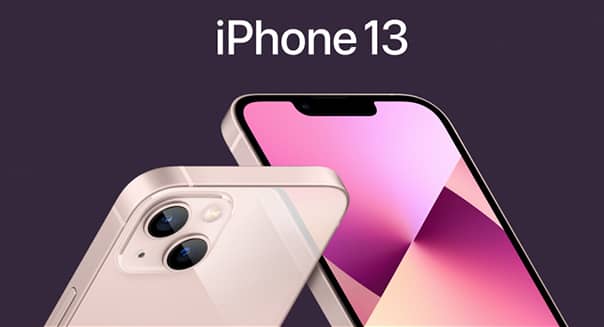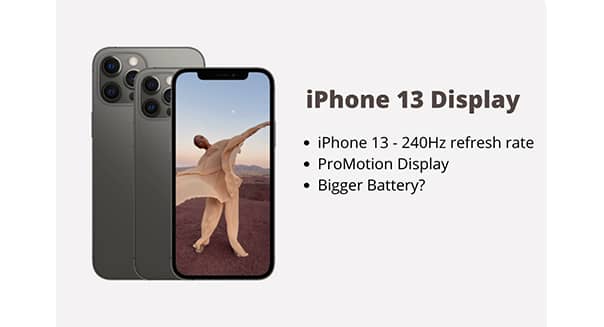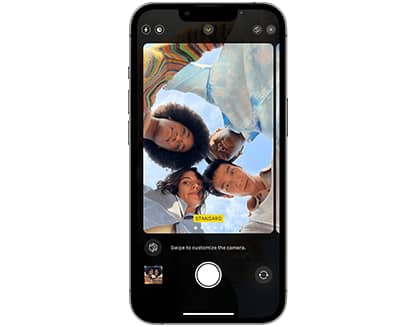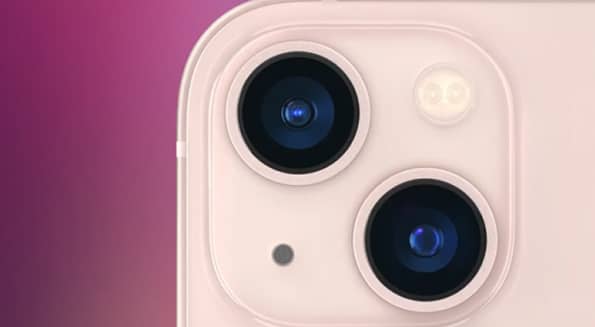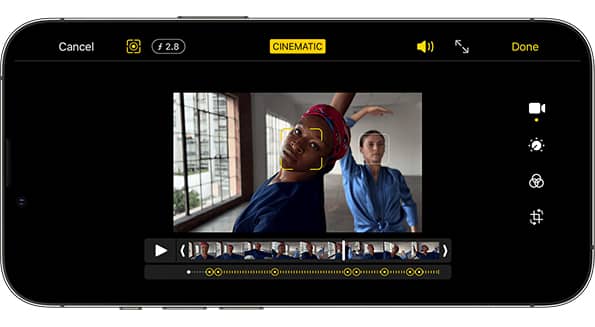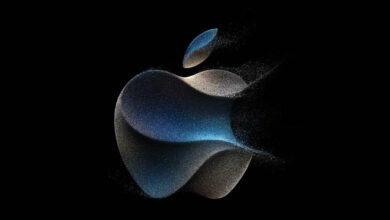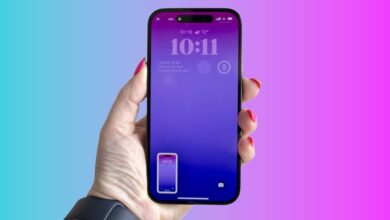iPhone 13: Specs, Features, Prices, Colors, Models, More
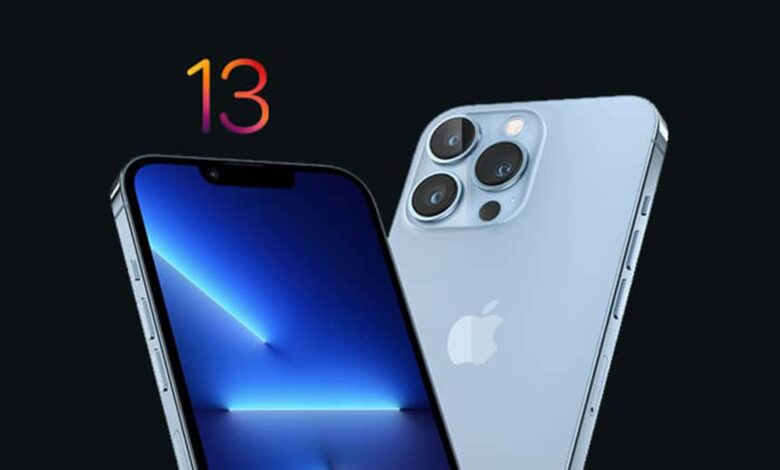
Choosing an iPhone is becoming quite sophisticated. Every year Apple releases more featured and optimized iPhones. That’s why we have put together everything you need t know about the latest Apple’s smartphone “iPhone 13” models.
Apple released four new iPhones, iPhone 13, iPhone 13 mini, iPhone 13 Pro Max, iPhone 13 Pro Apple’s latest flagship iPhones, launched on Sep 14, 2021.
The iPhone 13 & iPhone 13 mini are considered cost-efficient compared with more expensive ones, iPhone 13 Pro & iPhone 13 Pro Max. The iPhone 13 & iPhone 13 mini are the perfect option for those who don’t need pro-level camera features.
The differences between iPhone 13 models (iPhone 13 & iPhone 13 mini) and iPhone 12 models (iPhone 12 & iPhone 12 mini)
Both iPhone 13 & iPhone 13 mini are somehow identical to the iPhone 12 models. They are common in featuring flat edges, an aerospace-grade aluminum enclosure, a glass back. But there is a slight increase in thickness (7.65mm).
The 5.4-inch iPhone 13 mini is the successor to the iPhone 12 mini, while the 6.1-inch iPhone 13 replaces the iPhone 12.
The iPhone 13 models are available in Pink, Blue, Midnight (black), Starlight (silver/gold), and (PRODUCT)RED.
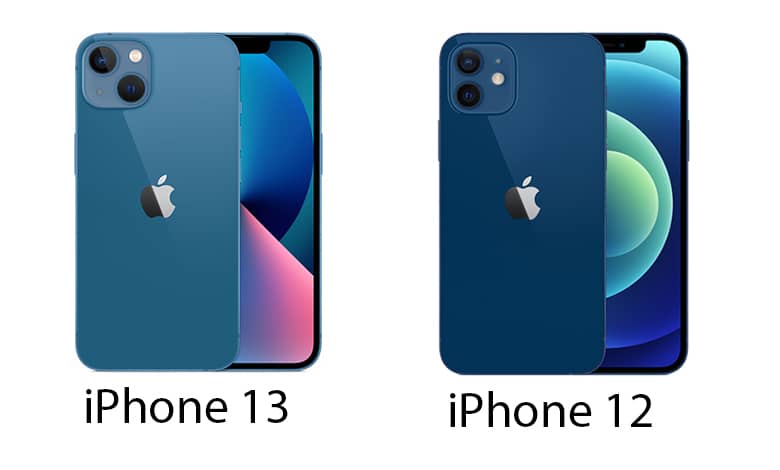
Both new models feature Super Retina XDR Displays 28 percent brighter than the iPhone 12 models. The iPhone 13 mini has a 2340×1080 resolution with 476 pixels per inch.
Whereas the iPhone 13 has a 2532×1170 resolution with 460 pixels per inch. In addition, both iPhones feature 1200 nits max brightness for HDR.
Moreover, True Tone matches the display’s color temperature to the ambient light, Wide Color for rich, vivid hues, and Haptic Touch for feedback.
Unlike the iPhone 12 models, the front-facing TrueDepth camera system is updated, and the Face ID notch is now smaller taking up less space. The iPhone 13 & 12 models have a Ceramic Shield cover glass with nano-ceramic crystals for more water protection.
However, IP68 water and dust resistance is added. The new versions can stay under up to 6 meters of water for nearly 30 minutes.
The upgraded A15 Bionic Chip powers the new iPhones. It features a 6-core CPU with two performance and four efficiency cores, a 4-core GPU (one less GPU core than the Pro models), and a 16-core Neural Engine.
There’s a new diagonal dual-lens rear camera with 12 megapixels Wide and Ultra Wide cameras. The Wide camera features an improved f/1.6 aperture that lets in 47% more light and Sensor-Shift Stabilization. At the same time, the Ultra-Wide camera features an improved f/2.4 aperture for enhanced low-light performance.
The iPhone 13 models added the Cinematic Mode to the existing ones: Portrait Mode, Night Mode, Time-Lapse. Cinematic Mode is a feature that uses rack focus to shift focus from one subject to another. It obliterates the background and creates movie-quality depth effects.
Cinematic Mode shoots in Dolby HDR, and the depth of field and obliteration can be adjusted using iPhone’s camera app. The iPhone 13 models also support 4K video recording at up to 60 fps.
Smart HDR 4 recognizes up to four people in a photo. It optimizes the contrast, lighting, and skin tones for each one. Deep Fusion, a carry-over from iPhone 12, activates mid to low-light scenes to bring texture and detail.
Photographic Styles are an upgraded kind of filter. It applies selectively to an image, muting colors or boosting vividness without impacting skin tones. There are Vibrant, Rich Contrast, Warm, and Cool options, along with settings for Tone and Warmth for customization and refining.
See Also: A look into Apple’s iPhone X Marketing Strategies
Apple’s iPhone 13 and 13 mini can be unlocked with the Face ID facial recognition system. It works with the 12-megapixel front-facing camera that supports Smart HDR 4, Deep Fusion, Night Mode, Cinematic Mode, Night Mode Selfies, and more.
As long as for higher-definition FaceTime calls and improved gaming. 5G connectivity is also included for better quality video streaming. Although the super-fast mmWave speeds are limited to major cities in the United States, slower sub-6GHz 5G speeds are available in more rural areas in the U.S. and other countries. Moreover, there are more 5G bands for 5G connectivity in more places.
The iPhone 13 and 13 mini support WiFi 6 and Bluetooth 5.0, plus they include a U1 Ultra Wideband chip for spatial awareness.
Gigabit LTE is supported when 5G isn’t available. It preserves battery life when using 5G. The Smart Data Mode reverts to an LTE connection when 5G speeds aren’t necessary. The new iPhone 13 models offer dual eSIM support and don’t come with a physical SIM by default, but there’s still a nano-SIM slot.
Battery life has improved significantly to larger batteries and the more efficient A15 chip. The iPhone 13 mini offers up to 1.5 hours more battery life than the iPhone 12 mini, and the iPhone 13 offers up to 2.5 hours more battery life than the iPhone 12.
Storage space starts at 128GB and goes up to 512GB at the high end. There’s a built-in three-axis gyro, an accelerometer, proximity sensor, ambient light sensor, and barometer.
Like iPhone 12 models, the iPhone 13 and iPhone 13 mini have built-in magnets. They are compatible with MagSafe accessories, charging at up to 15W with Apple’s MagSafe Charger. The iPhones also support fast charging, which provides 50 percent charge in 30 minutes with a 20W power adapter.
No power adapter or EarPods included with the iPhone 13 and 13 mini. You can purchase those accessories separately. They do ship with a USB-C to Lightning cable for charging purposes.
iPhone 13 Prices
iPhone 13 line nearly matches the cost of its predecessor (iPhone 12)
Although Apple has optimized the 64GB storage option for its standard and Mini options, the pricing of the iPhone 13 has stayed the same. The iPhone 13 Mini starts at $699 for 128GB of storage. The standard iPhone 13 starts at $799, the Pro starts at $999, and Pro Max at $1,099.
The prices for the Pro versions are similar to other high-end smartphone models. Their prices are like the Galaxy S21 Plus and Galaxy S21 Ultra prices, which cost $1,000 and $1,200, respectively.
iPhone 13 Design
The iPhone 13 models have nearly the same body design as the iPhone 12 models they replace. There’s an all-glass front and a colorful all-glass back housed in a color-matched aluminum frame.
A notch on the front display of the iPhone 13 houses the TrueDepth Camera, speaker, and microphone. This year, the notch is smaller, allowing for a more broad display area.
A set of antenna bands can be found at the top and sides of the phone, along with the power button on the right and volume/silence buttons on the left. Underneath the power button, there’s a 5G mmWave antenna, but iPhone 13 models in the U.S. will only include this antenna.
The iPhone 13 models have speaker holes and microphones at the bottom, along with a Lightning port for charging purposes. The SIM slot is located on the left side of the device.
A square camera bump is located at the back of the iPhone 13 models. Unlike iPhone 12 models that featured camera lenses in a vertical array, camera lenses in iPhone 13 models acquired a new diagonal setup.
Based on Apple, the diagonal layout allowed room for new camera technology like sensor-shift optical image stabilization.
iPhone 13 Colors
Apple has been offering its standard iPhone lineup in a range of bright colors for several years now. However, the iPhone 13 and 13 mini launched new colors. They include Starlight (a mixture between silver and gold), Midnight (black), Pink, Blue, and (PRODUCT)RED.
There is some overlap between the colors of the iPhone 13 and the colors of the prior generation. iPhone 12 models came in White, Black, Blue, Green, (PRODUCT)RED, and Purple, but the Starlight and Pink shades are new. The blue is also a lighter shade, while the red is more vivid.
iPhone 13 Sizes
The iPhone 13 models come in 5.4 and 6.1-inch sizes, with the 5.4-inch iPhone 13 Pro positioned as Apple’s smallest iPhone. This is the last year that Apple is planning to offer a smaller size, according to rumors, like its predecessor, the iPhone 12 mini, did not sell well.
Compared to the iPhone 12 lineup, the iPhone 13 and 13 mini are thicker and heavier.
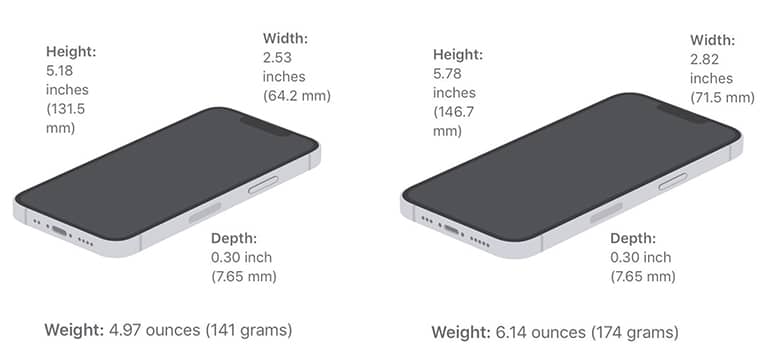
The iPhone 13 mini is 5.18 inches tall (131.5mm), 2.53 inches wide (64.2mm), and 0.30 inches thick (7.65mm). Whereas the iPhone 13 is 5.78 inches tall (146.7mm), 2.82 inches wide (71.5mm), and 0.30 inches thick (7.65).
The mini is the lightest phone in the iPhone 13 lineup at 4.97 ounces (141 grams), followed by the iPhone 13 at 6.14 ounces (174 grams).
iPhone 13 Display
All the iPhone 13 models feature the same OLED Super Retina XDR display, which is flexible and extends right into the chassis of each device.
There’s a 2,000,000:1 contrast ratio for blacker blacks and brighter whites, and up to 1200 nits peak brightness for HDR photos, videos, TV shows, and movies. Typical max brightness is 800 nits for the standard iPhone 13 models, 200 nits lower than the Pro models.
The 5.4-inch iPhone 13 mini has a resolution of 2340×1080 with 476 pixels per inch. The 6.1-inch iPhone 13 features a resolution of 2532 x 1170 with 460 pixels per inch.
Wide color support brings vivid, true-to-life colors, and True Tone. It matches the white balance of the display to the ambient lighting for a paper-like viewing experience that’s easier on the eyes.
There’s also a fingerprint-resistant oleophobic coating and support for Haptic Touch. It provides haptic feedback when interacting with the display.
iPhone 13 is Water Resistance
The iPhone 13 and 13 Mini feature an IP68 water-resistant rating. It enables the smartphones to withstand a depth of up to six meters (19.7 feet) underwater for up to 30 minutes, identical to the iPhone 12 models.
In the IP68 number, the 6 refers to dust resistance (and means the iPhone 13 can hold up to dirt, dust, and other particulates). Whereas the 8 pertains to water resistance. IP6x is the highest dust resistance rating that exists.
With the IP68 water resistance rating, the iPhone 13 can hold up to splashes, rain, and accidental water exposure. However, intentional water exposure should be avoided if possible.
Water and dust resistance are not permanent conditions, according to Apple, and can deteriorate over time as a result of normal wear.
Apple’s warranty does not cover liquid damage, which means it’s best to use caution when it comes to liquid exposure.
iPhone 13 Ceramic Shield
Apple is continuing to use the “Ceramic Shield” material that delivers better drop protection for the iPhone 13 models. The Ceramic Shield display cover is made by infusing nano-ceramic crystals into the glass.
The ceramic crystals were manipulated to optimize for clarity while maintaining toughness. Along with the display created in partnership with Corning.
According to Apple, Ceramic Shield is tougher than any smartphone glass. In addition to a dual-ion exchange process that ensures protection against scratches and everyday wear and tear.
In drop tests, iPhone 13 models have shown no improvements in durability compared to iPhone 12 models. It’s not a surprise since they feature the same Ceramic Shield display and glass body.
iPhone 13 Comes With Smaller Notch
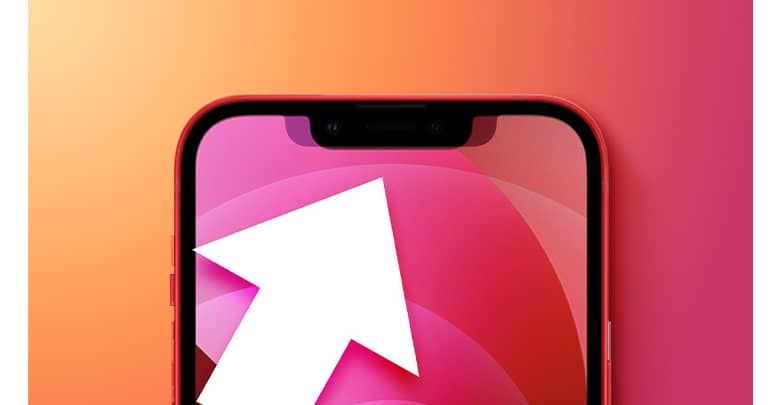
Apple slimmed down the notch that houses the TrueDepth camera system, and it’s 20 percent less wide than the notch used in prior iPhone models. Although the new iPhone 13 model’s notch is smaller, it’s a bit taller than the prior notch on the iPhone 12 models.
A15 Bionic Chip in iPhone 13
All the iPhone 13 models use Apple’s new A15 chip, which offers performance and efficiency improvements over the A14 chip used in the iPhone 12. There are two performance cores and four efficiency cores.
The A15 chip in the iPhone 13 models is only surpassed by the version in the iPhone 13 Pro models.
The A15 chip in the iPhone 13 and 13 mini features a 4-core GPU, which is one less core than is available in the iPhone 13 Pro and Pro Max.
For this reason, the iPhone 13 Pro and the Pro Max offer the fastest GPU performance, but the standard iPhone 13 models aren’t too far behind.
The iPhone 13 Pro models offer 50% faster graphics performance compared to the iPhone 12 Pro models. Whereas the iPhone 13 models offer 15% faster graphics performance.
When it comes to the CPU, the iPhone 13 models are approximately 10% faster in single-core performance. They are also approximately 18% faster in multi-core performance compared to the iPhone 12 models.
Testing by AnandTech indicates that the A15 is even faster than Apple’s own estimates. It’s also 62% faster than competing smartphones.
Neural Engine
The 16-core Neural Engine is able to perform up to 15.8 trillion operations per second, and it powers features like Cinematic Mode and Smart HDR 4.
iPhone 13 RAM
The iPhone 13 models have 4GB RAM, which is 2GB less RAM than the iPhone 13 Pro models. RAM has not changed from the iPhone 12 to the iPhone 13, and the iPhone 12 and 12 Pro models also had 4GB and 6GB RAM, respectively.
iPhone 13 Storage Space
All iPhone 13 models start with 128GB of storage, and the iPhone 13 and iPhone 13 mini can be ordered with up to 512GB storage space. That’s half the maximum storage space of the iPhone 13 Pro models, which come with up to 1TB.
TrueDepth Camera and Face ID
For biometric authentication purposes, the iPhone 13 models use Face ID. The facial recognition system was first introduced in 2017. Face ID components are housed in the TrueDepth camera system in the display notch, which is smaller this year.
Face ID is used across iOS tasks for many reasons. Such as unlocking the iPhone, and allowing access to third-party passcode-protected apps. Also for confirming app purchases, and authenticating Apple Pay payments.
Face ID works through a set of sensors and cameras. A Dot Projector projects more than 30,000 invisible infrared dots onto the surface of the skin. In order to create a 3D facial scan that maps the curves and planes of each face, with the scan read by an infrared camera.
The facial depth map is transmitted to the A15 chip. There it is transformed into a mathematical model that the iPhone uses to authenticate identity.
Face ID works in low light and in the dark. It also works with hats, beards, glasses, sunglasses, scarves, and other accessories that partially hide the face.
For face masks, which do not work with Face ID, there’s an “Unlock with Apple Watch” feature for convenience. Unlock with Apple Watch allows iPhone users to take advantage of an unlocked and authenticated Apple Watch as a secondary authentication measure to unlock their devices when wearing a mask.
It can’t be used to authenticate Apple Pay or App Store purchases, and it can’t unlock apps that require a Face ID scan. In these situations, a mask needs to be removed or a passcode needs to be used instead.
iPhone 13 Front-Facing Camera Features
The 12-megapixel f/2.2 camera in the TrueDepth camera system is not only facial recognition, but also it’s a front-facing selfie/FaceTime camera. It has many of the same features that are available for the rear-facing camera.
With the A15 chip, the iPhone 13 models support many of the photographic capabilities that are available with the rear cameras. They include Night mode for selfies, Smart HDR 4, Dolby Vision HDR recording, and Deep Fusion. As well as, ProRes and the new Cinematic Mode for capturing videos with a movie-like depth of field changes.
Moreover, 4K video recording, QuickTake video, Slo-mo video, Portrait Mode, Portrait Lighting, and the new Photographic Styles feature for selectively applying edits are all supported.
iPhone 13 Comes With Dual-Lens Rear Camera
The iPhone 13 and 13 mini include a diagonal dual-lens camera system. The Wide lens features an f/1.6 aperture, while the Ultra Wide features an f/2.4 aperture. The updated Ultra-Wide camera offers better low light performance, and the updated Wide camera lets in 47 percent more light.
There is no Telephoto lens in the iPhone 13 and 13 mini, so these models are limited to 2x optical zoom out and digital zoom up to 5x.
Sensor-shift optical image stabilization, a feature once limited to the Pro models, is available across the iPhone 13 lineup.
iPhone 13 Camera Features
- Smart HDR 4 – Recognizes up to four people in a scene and optimizes the contrast, lighting, and even skin tones for each person so everyone looks their best.
- Photographic Styles – Photographic Styles are smart, adjustable filters that can do things like boost or mute colors without affecting skin tone. Styles apply selectively to an image, unlike a filter that’s applied to the entire image. Photographic Styles include Vibrant (boosts colors), Rich Contrast (darker shadows and deeper colors), Warm (accentuates golden undertones), or Cool (accentuates blue undertones). Tone and Warmth are customizable for each style, so you can get the exact look that you want.
- Night Mode – Takes a series of images over a few seconds and aggregates them together to allow for photography in extremely low lighting situations.
- Deep Fusion – Works in mid to low lighting conditions and brings out the texture and detail in the image.
- Portrait Mode – Keeps the subject of the photo in focus while blurring the background.
- Portrait Lighting – Changes the lighting of Portrait Mode photos with effects that include Natural, Studio, Contour, Stage, Stage Mono, High‑Key Mono.
- True Tone flash – True Tone flash is the built-in flash, and it is designed to match the ambient lighting so it doesn’t throw off the white balance of the photo when used.
- Panorama – Captures panoramic shots up to 63 megapixels.
- Burst Mode – Allows a series of images to be captured all at once, which is good for high-action shots.
iPhone 13 Battery Life
Apple has improved battery life across the iPhone 13 lineup with the A15 chip and larger battery sizes. The iPhone 13 mini’s battery lasts for up to 1.5 hours longer than the iPhone 12 mini, and the iPhone’s 13 battery lasts for up to 2.5 hours than the iPhone 12.
The iPhone 13 mini supports up to 17 hours of video playback (13 hours when streaming), and up to 55 hours of audio playback. The iPhone 13 supports up to 19 hours of video playback (up to 15 hours of streaming) and up to 75 hours of audio playback.
The iPhone 13 is equipped with a 3,227 mAh battery, up from 2,815 mAh in the iPhone 12. Whereas the iPhone 13 mini has a 2,406 mAh battery, up from 2,227 mAh in the iPhone 12 mini.
Both iPhone 13 models support fast charging and can be charged to 50% within 30 minutes using a Lightning to USB-C cable and a 20W power adapter.
Video Recording in iPhone 13
The iPhone 13 models support up to 4K video recording at 24, 25, 30, and 60 frames per second. They also support HDR video recording with Dolby Vision at 4K up to 60 frames per second. 1080p video recording and 720p video recording are also available.
There’s a new Cinematic Mode that uses rack focus to seamlessly shift the focus from one subject to another when capturing video. It holds focus on the subject while blurring the background, and can automatically change the focus when a new subject is about to enter the scene.
Blur and focus can be adjusted after capturing video as well through the Photos app. The cinematic mode works with the Wide, Telephoto, and TrueDepth cameras, and it supports Dolby Vision HDR.
Other video features include QuickTake video, audio zoom, Time-lapse, Night mode Time-lapse, continuous autofocus mode, 3x digital zoom, and the option to take 8-megapixel photos when recording 4K video.
iPhone 13 Supports 5G Connectivity
The iPhone 13 models support 5G networks as well as LTE networks. The 5G modems in the devices work with both mmWave and Sub-6GHz 5G, which are the two types of 5G, but mmWave speeds continue to be limited to the United States.
mmWave 5G networks are the fastest 5G networks, but mmWave is short-range and can be obscured by buildings, trees, and other obstacles. That’s why its use is limited to major cities and urban areas along with venues. That includes concerts, airports, and other places where a lot of people congregate.

But Sub-6GHz 5G is more widespread and available in urban, suburban, and rural areas across the United States and other countries. For the most part, when you use a 5G network, you’ll be using Sub-6GHz 5G. Sub-6GHz 5G is generally faster than LTE, but it’s still evolving and it’s not the super fast 5G you might be expecting.
5G connectivity enables faster download and upload speeds. It speeds up everything from loading websites to downloading TV shows and movies. It also increases bandwidth for streaming services.
Therefore, you can watch in a higher resolution, and it brings improved FaceTime call quality. Over 5G or WiFi, FaceTime calls work in 1080p. In areas where LTE speeds are slow because of the sheer number of people, 5G frees up bandwidth and reduces congestion for faster usage speeds.
iPhone 13 Supports Dual SIM
Dual-SIM support allows two phone numbers to be used at one time, enabled through the inclusion of a physical nano-SIM slot and an eSIM. eSIM functionality is available in many countries around the world, and Apple has a list of carriers that support eSIM on its website.
The iPhone 13 models are the first with Dual eSIM support. They can use two eSIMs simultaneously rather than only one eSIM and one nano-SIM. Apple’s iPhone 13 models linked to a carrier will not ship with a physical SIM card this year and carriers will instead use eSIM capabilities for activation.
Data Saver Mode
Data Saver Mode is a feature that swaps the iPhone’s connection over to LTE when 5G speeds aren’t needed in order to preserve battery life.
As an example, when the iPhone is updating in the background, it uses LTE because super-fast speeds aren’t necessary. However, when speed does matter, such as downloading a show, the iPhone 13 models swap over to 5G. There is also a setting to use 5G whenever it’s available rather than using the automatic Data Saver Mode.
Bluetooth, WiFi, and U1
The iPhone 13 models include an Apple-designed U1 chip. It enables Ultra-Wideband technology for improved spatial awareness. It allows the iPhone 13 models to precisely locate other U1-equipped Apple devices.
Apple has likened Ultra Wideband to “GPS at the scale of the living room. That’s” because the technology is designed for improved indoor positioning and location tracking.
The U1 chip allows the iPhone 13 and 13 mini to precisely track nearby AirTags. It’s also used for directional AirDrop and interaction with the HomePod mini, which also has a U1 chip.
As for Bluetooth and WiFi, the iPhone 13 models support Bluetooth 5.0 and WiFi 6 (802.11ax).
Other iPhone 13 Features
Speakers
The iPhone 13 models have a stereo speaker at the top where the notch is located and a second stereo speaker at the bottom next to the Lightning port.
Sensors
The iPhone 13 models are equipped with a barometer, three-axis gyroscope, accelerometer, proximity sensor, and an ambient light sensor.
GPS and NFC
The iPhone 13 and 13 mini include support for GPS, GLONASS, Galileo, QZSS, and BeiDou location services. NFC with reader mode is included, and there’s a background tag feature that allows the iPhone models to scan NFC tags without the need to open an app first.
iPhone 13 Supports MagSafe
The iPhone 13 lineup continues to offer built-in MagSafe technology in the form of a magnetic ring. It’s designed to connect to the MagSafe charger and other magnetic accessories.
The MagSafe charger snaps right onto the back of the iPhone 13 models. It charges at 15W, which is higher than the 7.5W wireless charging available with Qi-based chargers.
Other magnetic accessories are compatible with the magnetic ring. Those accessories include cases, sleeves, snap-on wallets, and more. Along with third-party companies are also able to make accessories for the MagSafe iPhones.

Apple warns that MagSafe Chargers can leave a circular imprint on its leather cases, and a similar effect has been seen on silicone cases.
Apple also says that credit cards, security badges, passports, and keyfobs should not be placed between the iPhone and MagSafe charger.
Like all iPhones, the iPhone 13 models with their MagSafe technology can cause interference with medical devices. That includes pacemakers and defibrillators.
Apple recommends keeping MagSafe iPhones and all MagSafe accessories a safe distance away from implanted medical devices.
iPhone 13 Pro and 13 Pro Max
The iPhone 13 and 13 mini are being sold alongside the iPhone 13 Pro and Pro Max, which are this year’s high-end flagship smartphones. Compared to the iPhone 13 and 13 mini, the Pro models offer a higher build quality. They also have features that aren’t available with the more affordable iPhones.
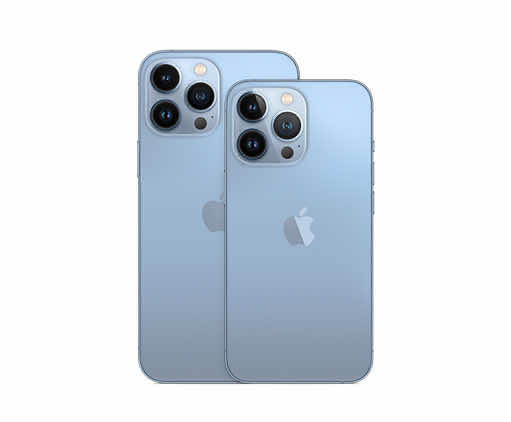
Compared to the standard iPhone models, the iPhone 13 Pro and Pro Max feature a stainless steel frame. Along with 120Hz ProMotion displays, and triple-lens camera systems. A well as improved Wide, Ultra Wide, and Telephoto lenses. Moreover, they feature higher-end photography options like macro capabilities and the ProRes video format.
iPhone 13 How-Tos
The Coming iPhone 14
The iPhone 13 models will be succeeded by the iPhone 14, and we’re already hearing rumors about the 2022 devices. Apple is expected to do away with the notch for at least some models, adopting a hole-punch front-facing camera and under-display Face ID.
The iPhone 14 models could also feature a new design that does away with the camera bump. Instead of introducing a flush camera design for the first time in many years.
